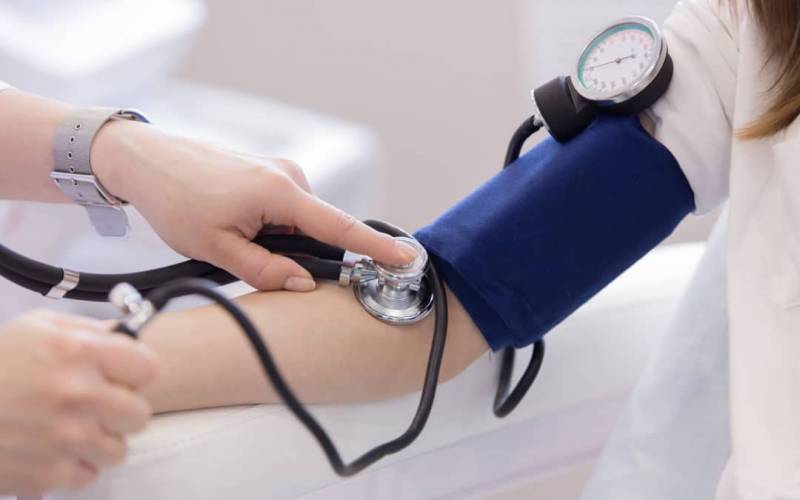High blood pressure is a known risk factor for a bout of Covid-19 severe enough to raise the specter of hospitalization and death. In fact, research has shown having high blood pressure doubles the risk of having a severe case of Covid, even if you are fully vaccinated and boosted.
Blood pressure is measured in units of millimeters of mercury (abbreviated as mmHg), which consists of two numbers — an upper or systolic reading that represents the maximum amount of pressure in your arteries, and the lower or diastolic reading that shows the pressure in your arteries when your heart muscle is at rest between beats.
But what is considered a high enough blood pressure reading to trigger that risk? To date, scientists haven’t been sure. Now, a new study out of England published Wednesday in the journal PLOS One has answered that question. “We found that in those with diagnosed hypertension, the risk of Covid-19 significantly increased once the high number exceeded 150 mmHg or the low number exceeded 90 mmHg compared to a target blood pressure (120-129/80-89 mmHg),” said lead author Holly Pavey, a doctoral student at the University of Cambridge in the United Kingdom who is funded by the British Heart Foundation, via email.
The research found people with this level of uncontrolled high blood pressure are more likely to be admitted to the hospital and die from a Covid infection, regardless of other known risk factors such as age, ethnicity or obesity. The new study was able to drill down and be more specific because of the inherent integration in the UK National Health Service. That level of data sharing allows access to “really granular data on long-term blood pressure control for their patients,” said Dr. Joseph Ebinger, an assistant professor of cardiology and director of clinical analytics of the Smidt Heart Institute at the Cedars-Sinai Medical Center in Los Angeles. “They found it’s not just the diagnosis of high blood pressure — yes or no — but that the risk goes up as your systolic blood pressure goes up, which is really a measure of lack of control,” said Ebinger, who was not involved in the study.
Unfortunately, many people fail to properly control their blood pressure, even after they have been diagnosed and are on medication, Ebinger added. “It’s estimated that less than half of individuals with a diagnosis of high blood pressure actually have control over their hypertension, so this is a big problem,” he said. “That’s due to a myriad of factors: underdiagnosis, lack of awareness, medication nonadherence and undertreatment.” On the positive side, successfully reducing blood pressure through medication was linked with a corresponding reduction in risk for severe Covid, the new study found. “It is really important for individuals to have regular blood pressure checks and for doctors to try and get their patients’ blood pressure controlled,” Pavey said.
“Controlling the blood pressure to target levels is important, irrespective of the type of treatment used to achieve it,” she said. “Ultimately blood pressure control will help to reduce the risk of suffering severely from new strains of Covid-19 or other viruses in the future.”
A primer on blood pressure
Blood pressure readings can be confusing — there are a lot of numbers tossed around, and medical professionals haven’t exactly made it easy for people to follow along.
“Normal” blood pressure readings are typically 120 mmHg systolic (upper reading) over 80 mmHg dystolic (lower reading), according to the US Centers for Disease Control and Prevention.
That’s likely the number you’ll hear mentioned most often. However, that may not be the number your doctor uses to treat you, Ebinger said. Doctors used to target a blood pressure reading of less than 140/90 to control risk for cardiovascular disease and death, he explained. Then, in 2015, results of SPRINT, or the Systolic Blood Pressure Intervention Trial, were published in The New England Journal of Medicine — findings that changed the thinking of many medical professionals. The SPRINT research found targeting a blood pressure below 120 systolic (the top number) in people with hypertension — but no diabetes — prevented the most cases of heart disease and death. There were some side effects, however, including a “higher rate of acute kidney injury or acute renal failure in the intensive-treatment group,” according to the trial. That possibility was concerning when it came to the elderly, who often have multiple chronic diseases such as type 2 diabetes, kidney concerns and more, Ebinger said.
“So in 2017, the American College of Cardiology and American Heart Association guidelines shot the gap and set the guideline of a systolic reading less than 130 and a diastolic of less than 80,” Ebinger said. “And this is where some of the debate starts to come in between different types of doctors. I’m a cardiologist, and we believe lower is better. We want to push that number down as much as we can.
“Some primary care doctors and geriatricians might say, ‘You know what, that may not be the best thing for some of my patients,’ and they’re going to treat to a higher number,” he said. “So this is where clinical practice and some of the guidelines don’t always add up.”
Here are current medical guidelines, according to the US Food and Drug Administration:
- Typical normal blood pressure is 120/80 or lower.
- Readings between 120/80 and 129/89 are considered pre-hypertension, meaning it’s not as low as it should be but is not yet considered high blood pressure medically.
- Blood pressure is a stage 1 red flag high if it reads 130/80.
- Blood pressure of 140/90 or higher is considered stage 2 hypertension.
If your blood pressure reads 180/110 or higher more than once, seek out medical treatment immediately. Reading at this high level is a “hypertensive crisis,” the FDA said.




